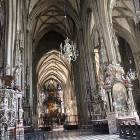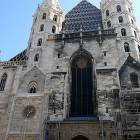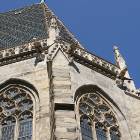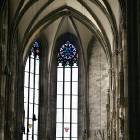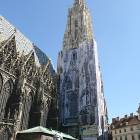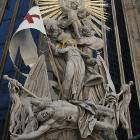Stephansdom, St Stephen’s Cathedral in Vienna, or when the Gothic gets scary
The story of the landmark church of Vienna starts almost nine hundred years ago, with what was started as a Romanesque edifice. From the very beginning it was dedicated to probably the first martyr of Christianity. St Stephen was killed with stones by the Jews that considered his faith a heresy against the law of Moses. Saul of Tarsus, later the become the prominent Apostle Paul, took part at least to the trial, if not to the stoning itself, before becoming a Christian himself.
Two centuries after the consecration of the small Romanesque church, it was extended employing the style of the middle age in Western Europe, Gothic. As this side of the continent fell under the migratory tribes who were gradually christened, elements from their traditions and imagination were incorporated into their new faith. Nordic legends made their way into the lives of the saints and superstitions were tolerated by the preachers. Fearing the ignorance of the masses, the Catholic bishops banned even the private reading of the Bible, creating a monopoly of interpretation. Local languages were also thought to be immature and incapable to render the meanings of the Sacred Scripture, so when new generations appeared, who could not understand Latin, they were often receiving the text as a mysterious incantation rather than a rational discourse.
The ignorance of the people was in a way encouraged by the Catholic church, with horrifying legends about the after life. Odd creatures started to appear in sculptures on the outside of the church, from the mythology of the barbarians. Thus, when humanism, and later Renaissance exploded, with its emphasis on reason, on human life, on sensual pleasures and joy, it is no wonder that the style of the previous era was mocked as a sign of questionable taste and superstition. The authors living during Renaissance named this style Gothic, as a pejorative term referring to the barbaric influences of that age. However, Gothic created some masterpieces of architecture, especially in cathedrals who are recognizable by their pointed arches, the incredibly high and thin walls, supported by flying buttresses and by the ceilings with ribbed vaults. The buttresses were a neat invention, that practically moved the columns from inside to the outside of a building. With clean thin walls, immense windows could be added, employing the art of stained glass, which could now create an ocean of colorful light entering the church.
Its hard not to notice from afar the beautiful tile roof of St Stephen’s cathedral in Vienna, with its beautiful green and white arrangements. A luxurious forest of pinnacles surround the main nave. But the overall impression when examining the exterior and the inside is very grim. The countless griffins that seem to be shouting while jumping from the top of the church, create a horrifying image, while the pollution turned the entire outside into pitch black. It is like medieval and modern barbarians joined hands to create something that is rather scarry than inviting. This used to be white, but the limestone changed color with time.
The highest tower has 136 m and holds the double headed eagle of the Habsburgs, that became the coat of arms of Austria. It dominates the old town of the Austrian capital even today.
In a capital so tied with classical music, the most representative cathedral could not have its own connection with music. Legend has it Beethoven knew he was completely deaf when he saw pigeons fly, but couldn’t hear the bell of the cathedral, and also the ceremony after the death of Italian composer Antonio Vivaldi was held in Stephansdom.
- Home Page
start page - Architecture
landmark buildings - Sacred architecture
places of worship - Nature
landscape photography - Concert
performing artists - Christmas
Santa Claus pictures
- Jooble
jobs for photographers - Escape
an out of control blog - Merry Christmas
The best organizer of Christmas parties - Astro photo
Eclipse hunting and astrological photography





